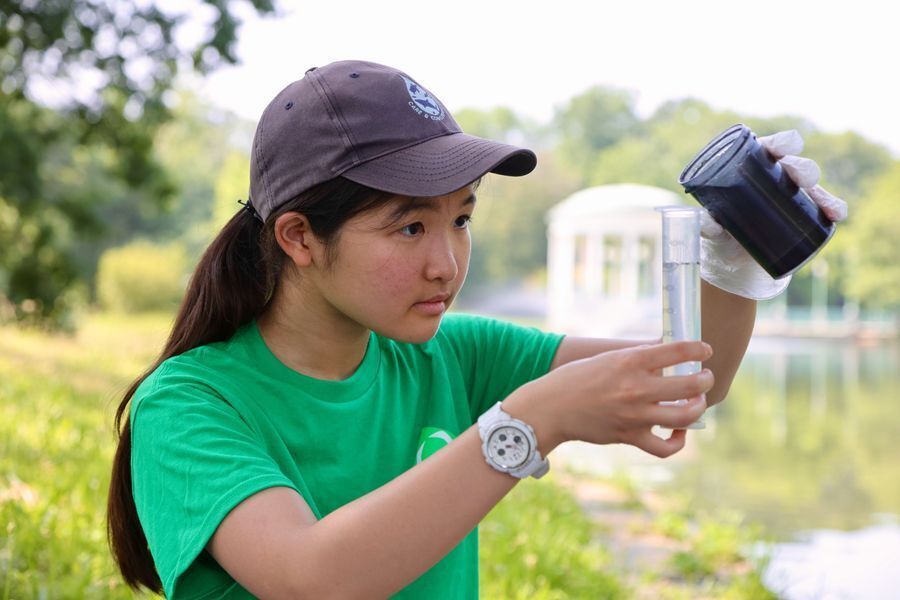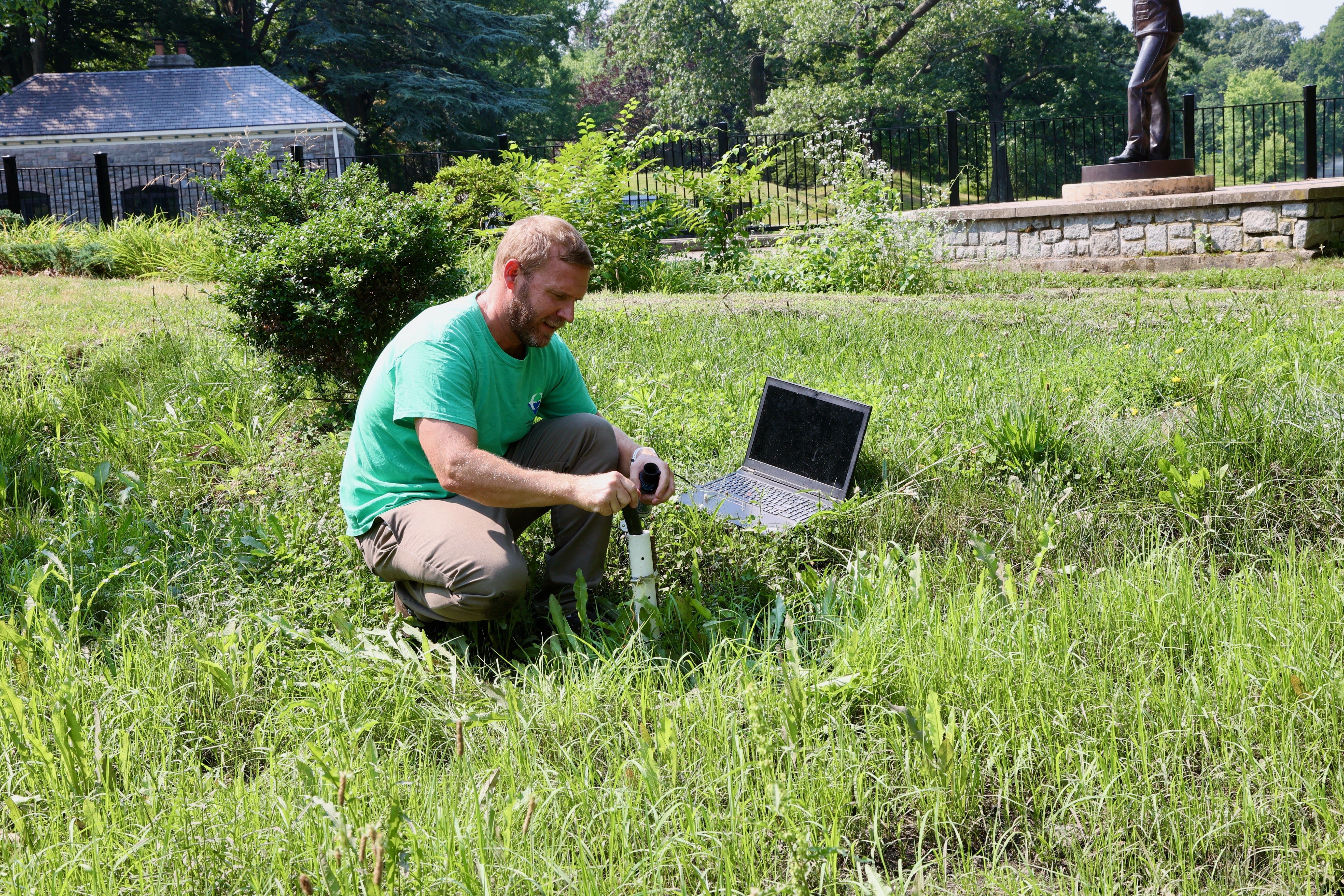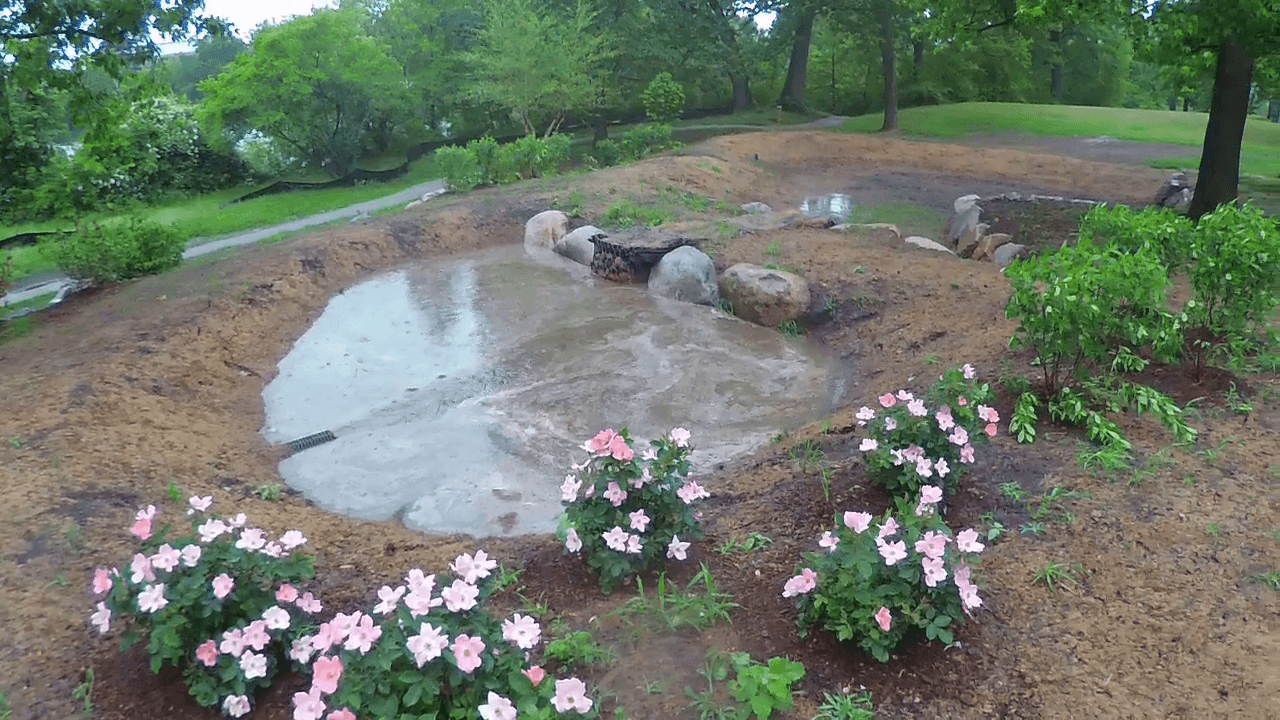
Published August 22, 2023
The Poison in Our Ponds: Cyanobacteria Blooms are on the Rise
By Sue Kennedy
It’s a muggy June morning, and Ryan Kopp, director of the Stormwater Innovation Center (SIC), leans slightly over a railing, peering at the amber colored surface of Roosevelt Lake at Roger Williams Park in Providence. There’s a faint skim of lighter colored material beneath his gaze, and he gives it a nod. “See that? It could be the start of a cyanobacteria bloom,” he says. “Those blooms develop to look like someone poured bright green paint in the water.”
Kopp steps back from the railing that skirts the park’s Seal House and points to colorful boards attached to the metal. Signage has been created for the public that describes and illustrates SIC efforts to bring sound science and policy to bear on stormwater issues in Rhode Island. He taps a diagram on a board. “If there’s one central takeaway, it’s that algae overgrowth – whether it’s cyanobacteria or not – reflects ecological imbalance that is largely human-driven.”
“If I had to pick a word to describe the problem, it would be ‘nutrients,’ and they’re mostly from us,” says Kopp, whose background in environmental science informs his focus on water quality issues. “I can show you great projects here in the park that are helping, but it’s equally important that we, as community members, recognize what can be done on our own to reduce these nutrients.”
The sun climbs higher; a pair of Canada Geese paddle the lake while two joggers, faces red and perspiring in the heat, pass Kopp. He motions north toward Willow Lake, saying stops will be made at a couple project sites. Likely, he says, there won’t be any cyanobacteria or blue-green algae – the terms are interchangeable for practical use – to view. “It’s kind of early for here, but if this year’s anything like last year, we’ll be seeing blooms sooner than later.”
With the blooms comes a ramp-up in public education; Kopp knows from previous years that he’ll be pointing out advisory signs to those park visitors fishing along the shore – “sometimes they leave, sometimes they don’t” – and advising parents to curtail their children from feeding bread or snacks to the waterfowl – “it’s not healthy for ducks and geese, and increases bird waste” – and pointing out algae blooms of all kinds to visitors when he sees it.
He projected the blooms correctly, as by mid-July, Rhode Island had already posted seven cyanobacteria advisories for local lakes and ponds, and only one, for Tiogue Lake in Coventry, had been lifted. And while it’s too soon to know whether this year’s advisory tally will surpass the 2022 total of 23, Kopp’s tour makes a clear point: If development and climate change exacerbate blue-green algae, then people have the opportunity to respond. “We’re doing that here, by implementing green infrastructure, but the impact would be much greater with an overall community effort to reduce the amount of nutrients in stormwater,” says Kopp.
Once it reaches excessive amounts, the toxins it sometimes creates can become overwhelming and sicken pond or lake life. Further problems happen as the algae cycles, dying off in rafts and robbing the water of oxygen, a situation that can choke the fish upon which many birds and other animals subsist.
Couple these obstacles with the increasingly prevalent issue of warming waters, a key impact of intensifying climate change, and opportunity for blue-green algae blooms ripens measurably. “We’re seeing longer and warmer summer and fall seasons,” says Chace. “It’s definitely having an impact.”
GREEN INFRASTRUCTURE: ONE PART OF THE NUTRIENT SOLUTION
Back at the park, about halfway between the Seal House and Willow Lake (heavily engineered via park construction, the “lakes” are portions of a single waterbody), Kopp has come to a stop. Sweeping an arm, he calls attention to the slight depression in the grassy ground and to the swathe of cobble-like rocks stretched beside it. Unassuming though it may appear, this vegetated and stony area is actually an innovative storm-water drainage tool – a green infrastructure solution.
“It’s a very simple, very smart solution,” says Kopp, pointing out how the rocky arc has been constructed to shunt water away from a park road and toward the grassy dip, where several bushes serve as sponges for excess water. “First the runoff is diverted from the roads, so it is kept out of the water bodies, then it is being cleaned as it soaks down through the soil.”
Other pluses include a more attractive landscaped footprint and the ability to precision-tailor drainage designs to the needs of specific sites as they change over time. With over 30 examples of such structures at the park as well as in locations statewide, much has been learned about green infrastructure science, policy, and practice.
The Stormwater Innovation Center is a result of a state directive years back that required the City of Providence to address stormwater issues. “We are gaining new information all the time about how green infra-structure is helping address water quality issues that really have so much to do with these algae blooms and other problems,” says Kopp. “These systems can and do work, and part of our job at the Center is to under-stand and measure this so we can improve them further.”
The SIC is enlisting volunteers this year to use a new website called RainSnap and upload photos and videos of stormwater and green infra-structure during rain events around the Providence metro area. The purpose is to help communities assess the functionality of these systems, which are designed to reduce flooding and filter polluted stormwater. These assessments can be used to improve the design and maintenance of green infrastructure, ultimately leading to better water quality and more climate-resilient communities. And community involvement is key.
While green infrastructure represents a world of advancement over the aged and pitted concrete pipes that once streamed runoff directly into park waters, obstacles remain. The more straightforward of these obstacles, Kopp indicates, reflects the administrative and logistical arena, the ongoing planning efforts to ensure green infrastructure is built, maintained, evaluated, and enhanced for the longer haul.
It’s a larger, more complicated obstacle that heightens the urgency of the SIC work. “The drainage structures are helping, but it’s going to take a community effort – government, environmental advocates and organizations, and local community members – to really make a difference with imbalances like the kind causing these cyanobacteria blooms,” he says.
A THREAT TO WILDLIFE: PEOPLE AND PETS AND STATE EFFORTS TO RESPOND
While on a virtual call, expressions on Chace’s face alternate between appreciation, concern and frustration. Appreciation accompanies his accounts of wildlife – gulls, ducks, and osprey, for instance – that he has studied and admired over years of field work, and the opportunities he has had to value the “richness and complexity” of Rhode Island and regional ecosystems.
Concern and frustration, on the other hand, mirror his grappling with the negative impacts of environmental degradation which seem to be worsening. “There are several significant problems with what we’re seeing in these ecosystems,” says Chace. “In terms of the cyanobacteria issue itself, it can cause illness in animals, in birds, especially if toxin is ingested, so that’s clearly a problem. But the much larger problem is what this means for our ecosystems as a whole. Let’s say small fish ingest this, and they then are a food source for other animals, such as birds,” he says. “The impact is biomagnified as the toxin moves up the food chain.”
With Almy Pond in Newport being a regular focus of his ecological research, Chace sees evidence of the stress that is being placed on the water and its inhabitants. He sees geese “gulping globs of gunk” – algae of some sort – and snapping turtles with similar muck on their feet and shells or carapaces. Whether it’s cyanobacteria or not, it’s an unhealthy situation, for animals and people alike. “That’s why when I am out there, I’m wearing raingear,” he says. “When I’ve got students out there, I’m always making sure we’re keeping our hands covered and away from our eyes and faces.”
The Rhode Island Department of Environmental Management (RIDEM) has taken on the state’s work of understanding and addressing how ecosystems and wildlife are being impacted by cyanobacteria and other kinds of water quality issues. Information posted on the RIDEM web site indicates that excessive toxins from blue-green algae can sicken or kill animals either through consumption or absorption through the skin. Fish can grow ill from swimming in toxin-laden water or can suffocate if algae decays and removes too much dissolved oxygen from the surrounds.
Applying science, collecting data, and communicating with the public are three options the state uses to address the issue as effectively and comprehensively as possible. “We monitor water quality, we work with the Department of Health to test for toxin, and we work with the public so we can both provide information as well as gather it,” says Jane Sawyers, a RIDEM environmental scientist who works on water quality issues, including cyanobacteria. “It is definitely a two-way street, in that sense.”
The work is substantial, with summer and early fall representing “high season” in terms of algae bloom assessment. The science team that Sawyers serves on includes a field crew whose members regularly surveil 17 local water bodies to collect samples. The team also responds to community inquiries – laboratory testing is necessary for identifying cyanobacteria toxin – and coordinates with the Rhode Island Department of Health (RIDOH) to provide a notification and signage program, with both health and recreational advisories, to the public.
The history of the effort highlights the gradual yet steady uptick of cyanobacteria blooms in the state, which is in keeping with the regional picture. As early as 2009, RIDEM began considering data concerning possible sightings of cyanobacteria, which often takes on a bright green “spilled paint” appearance as it overgrows. By 2011, advisories were being posted, and more than 170 such notices for state water bodies have been made to date. Today, a joint RIDEM/RIDOH team partners on the research and outreach components, both of which are necessary to respond to the issue.
Sawyers says the joint effort has been successful in the immediate goals of gathering the data necessary to inform health and safety goals, and for helping ensure people have the needed information and know where to turn for resources. But, echoing Kopp and Chace, she’s not surprised to see that science is pointing to an increasingly complicated situation.
If people play a role in creating the environmental imbalance that causes blue-green algae blooms, they also, due in part to the state’s efforts as well as increased media attention, are more aware of the problem and are making use of opportunities to assist. Jillian Chopy, a RIDOH program manager with an environmental science background, collaborates with Sawyers and the RIDEM team on cyanobacteria management; she describes an environmental challenge that now poses potential hazards to humans and what they value in a shared ecosystem. “While we’ve been working on this for quite a while, it really seems to have picked up as an issue for people once there was evidence of dogs – pets – getting sick,” says Chopy. “That seems to have been a critical point.”
Dogs that wade or swim in lakes or ponds have an increased risk of get-ting sick from blue-green algae as they could swallow toxin in water, eat animals or material containing it, or ingest toxin from licking their coats and skin. No fatalities have been documented in Rhode Island thus far for either humans or pets, but it will be important, Chopy says, for the public to stay aware of possible threats, especially during summer and fall. “We receive many more phone calls now from people concerned about the health risks associated with these algae blooms,” she says. “Public awareness is increasing, and more people definitely want to know now what to do to keep themselves and their pets safe.”
There are several ways for people to get involved in community-based efforts to address blue-green algae, other kinds of blooms and water quality issues, and ecosystem balance in general. Residents can undertake steps to reduce their household and yard nutrient loads – again, cutting fertilizer and picking up pet waste – join community monitoring pro-grams, and participate in local and state dialogues concerning water quality, stormwater management, and climate change issues (See resources list at end of article.).
And while blue-green algae has emerged as a spotlight issue, Kopp is quick with the overall reminder that the overgrowth of any algae signals imbalance – something that’s never good for an ecosystem. He’s at the end of the tour, having explained the workings of a third example of green infrastructure – a vegetated drainage ditch that helps keep water from flowing across a road and into Willow Lake.
“It’s important that communities learn how their decisions and actions contribute to the causes of these algae and bacteria blooms,” says Kopp. “If we can collectively work to decrease our nutrient loads even a bit, then these structures are going to be able to work more effectively.”
For now, as he starts to make his way back to the Seal House, Kopp says that he’ll continue what he sees as a triple-approach process to improve the health of the park’s ecosystem – collecting the science, applying green infrastructure, and, above all, engaging the public. “All three aspects are equally important, equally needed to deal with algae blooms and ultimately improve the environment overall,” he says. “We are all in this together, and we can do more collectively to address it.”
LEARN MORE:
Examine a RIDEM trove of blue-green algae data and reports: https://dem.ri.gov/bluegreen
Think you see a bloom? Send RIDEM an email with pictures and location descriptions: DEM.OWRCyano@dem.ri.gov.
Visit RIDOH for human and pet health risks of cyanobacteria: https://health.ri.gov/healthrisks/harmfulalgaeblooms/
See other tips from the U.S. Environmental Protection Agency for reducing your household nutrient load: https://www.epa.gov/nutrientpollution/sources-and-solutions-and-around-home
Find out more about green infrastructure stormwater solutions and consider becoming a SIC water quality community monitor: https://www.stormwaterinnovation.org/
Stop by the Stormwater Innovation Center in Roger Williams Park and take a self-guided tour of the green infrastructure installments. Brochures are available outside of the Seal House.
Sue Kennedy is a communications specialist for the URI Coastal Resources Center, serves on the Warwick Wildlife & Conservation Com-mission, and enjoys freelancing; reach her at skennedy1168@gmail.com.




















